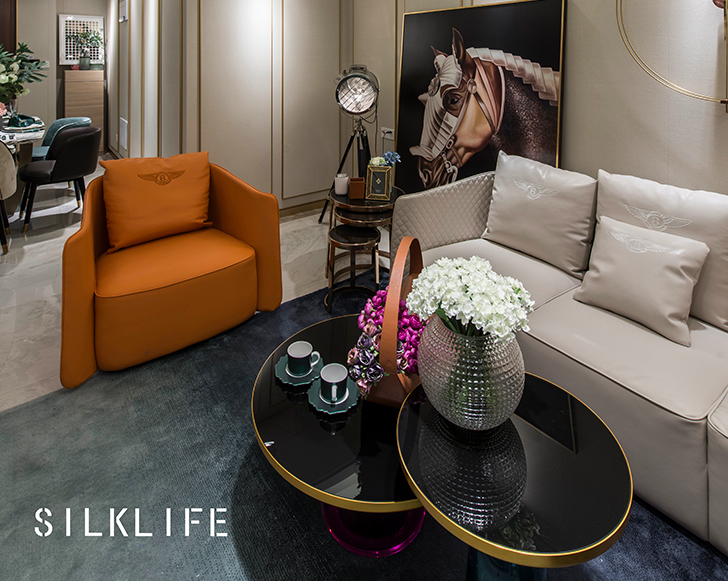Soft decoration design and decoration All movable elements in commercial space and residential space are collectively referred to as soft decoration. The elements of soft decoration include furniture, decorative paintings, ceramics, flower art and green plants, curtain fabric, lighting, and other decorative decorations; The scope of soft decoration includes family residence and commercial space, so there are also some large and small soft decoration training institutions in China. Overall household soft decoration
Soft decoration refers to soft decoration and soft decoration. Compared with the traditional "hard decoration" form of interior decoration. That is, the second use of replaceable and renewable fabrics, curtains, green plants, iron arts, paintings, tapestries, etc. after the completion of the decoration of the room High end soft decoration Decoration. Overall household soft decoration
The soft decoration products involved in the soft decoration design include furniture, lighting, curtains, carpets, hanging pictures, flower art, ornaments, green plants, etc. According to customers' preferences and specific soft decoration styles, through the design and integration of these soft decoration products, the space is finally constructed according to a certain design style and effect, and finally the whole space is harmonious, warm and beautiful.
With the continuous development of the times, people have come into their lives. The Chinese people have only known about this decoration concept that originated in Europe and is popular all over the world in recent years. Of course, it has developed from coastal areas to inland areas. Soft decoration design has been defined and interpreted by people.

In fact, it can also be understood that "hard clothes" are similar to human body bones, which are difficult to change after they grow and take shape. They need to be beautified by the acquired "soft clothes". Similar to many girls, although they are born with bad looks, they will also become beautiful women through the dedicated decoration of makeup artists.
Similarly, soft dress designers are similar to makeup artists. No matter what your place is born with, whether it is "tall, rich and handsome" or "short, poor", they can deepen the degree of "tall, rich and handsome" or make it "tall, rich and handsome" by focusing on soft dress design.
Soft decoration can generally be summarized as movable Decorations that are easy to replace (such as curtains, sofas, wall hangings, carpets, bedding, lamps, glass products, furniture and other furnishings, furnishings and the like) can all be called soft decoration, that is, the overall soft decoration of the home.
"Soft decoration" can also comprehensively plan the decoration design scheme according to the size and shape of the room space, the host's living habits, hobbies and their respective economic conditions, reflecting the owner's personality and taste, rather than "thousands of families". Compared with the one-off and untraceable characteristics of hard decoration, soft decoration can be replaced at any time to update different elements. Different colors and styles of curtains, sofa covers, bedspreads, tapestries, paintings, green plants and other elements can be changed in different seasons. In today's home decoration, the design of soft decoration can not be ignored. Every picture and decoration reflects the taste and personality of the residents. Bernard Shaw once said, "You have one idea, and I have one idea. When we exchange ideas, we will have two ideas." For home decoration designers, ideas can change the design ideas, concepts and even the future of designers.
The so-called soft decoration, also called soft bag, refers to the second decoration and arrangement of the interior by using the ornaments and furniture that are easy to change and change positions, such as curtains, sofa covers, cushions, craft tablecloths and decorative handicrafts, decorative iron arts, etc. Home decoration, as a movable decoration. Soft decorative art originated in modern Europe, also known as decorative art, also known as "modern art". It rose in the 1920s. With the development of history and the continuous progress of society, and under the background of the vigorous development of new technology, people's aesthetic awareness is generally awakened, and the decorative awareness is also increasingly strengthened. After nearly 10 years of development, the soft decoration art came into being in the 1930s.
The decorative patterns of soft decorative arts are generally geometric or evolved from concrete forms. The materials used are rich and valuable. In addition to natural materials (such as jade, silver, ivory and crystal stone), some artificial materials (such as plastic, especially phenolic materials, glass and reinforced concrete) are also used. The typical themes of its decoration include naked women, animals (especially deer and sheep), the sun, etc. It draws lessons from American Indians, Egyptians and early classical art, reflecting the enlightenment of nature. For various reasons, soft decoration art was not popular in World War II, but it has attracted people's attention again since the late 1960s and has been revived. At this stage, soft decoration has reached a relatively mature level.
With the increasing popularity of soft clothing, and with the continuous emergence of some high-end soft clothing Hangzhou Qingfeng College, the development prospect is considerable. Soft clothing has formed another fashion industry alone, and there is a huge talent gap, and the employment prospect is optimistic.

